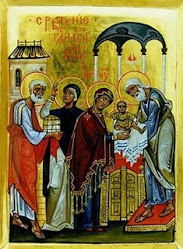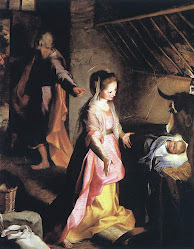The Historicity of Nazareth
For Some reason Many skeptics have taken to the notion, one laid to rest long ago, that Nazareth never existed as an inhabited city in the time of Jesus. They point to a website which calims that the author has excavated the stie of ancient Nazareth and found it to be a mere single family farm.
Basically this is an argument from silence, there are four major points
Josephus never mentions Nazareth, and apparently it isn't mentioned in any other records of the day. Josephus even documents a military campagin that the Romans into the very vacinity of Nazareth and yet no mention of it.
Apprently some claim that the only evidence of human habitation from Christ's time would have been caves in the area, but Jews would never live in caves because they used caves to bury people, and as there are graves near by they would never live in graves or near dead bodies
The geography is wrong. Apparently there is no cliff near the Synagague which Jesus might be thrown off of as is seen in Luke.
It is always pointed out that a popular website of an excavation of Nazareth calls it a "single family farm."
I. The Argument from Silence
A Argument from silence is never proof of anything.
An argument form silence is no proof at all. Yet this is the basis of the first Skeptical argument. Josephus doesn't mention Nazareth. But that's because he was not writting a travel logue. He had no reason to mention it, it was a very small and unimportant village; almost a bump in the road, that does not prove that it didn't exist.
Nazareth was a tiny bump on the road. It was only four miles form a major city (Sarapis) but it was so small only about 35 families lived there and shared a single family farm, a dray farm, subsisting on only rain water. It was a tiny insignificant place so there is no reason why it should be mentioned.
B Joesephus doesnt' mention it, but it is mentioned in Antqiuity.
Two mentions in antiquity
"Despite the Hellenization of the general region and the probability that Greek was known to many people it seems likely that Nazareth remained a conservative Jewish village. After the Jewish war with the Romans from AD 66-70 it was necessary to re-settle Jewish priests and their families. Such groups would only settle in unmixed towns, that is towns without Gentile inhabitants. According to an inscription discovered in 1962 in Caesarea Maritima the priests of the order of Elkalir made their home in Nazareth. This, by the way, is the sole known reference to Nazareth in antiquity, apart from written Christian sources... (next paragraph) Some scholars had even believed that Nazareth was a fictitious invention of the early Christians; the inscription from Caesarea Maritima proves otherwise." Paul Barnett[BSNT], Behind the Scenes of the New Testament, IVP:1990, p.42:
C Patristic Evidence
Franciscan cyerspot
http://christusrex.org/www1/ofm/san/TSnzarc2.html
Even the judeo-christian historian Hegesippus (late second century) gives witness to these next-of-kin of the Lord when speaking about a persecution of the Christians by Emperor Domiziano (81-96 AD) and whose writings are quoted by Eusebius (IV cent. AD) in his History of the Church (III,19.20,1-6). Jiulius the African (250 AD) mentions how the descendents of Jesus were jealous in keeping alive the memory of their forefathers (a passage quoted by Eusebius in his History of the Church I,7,13-14). During the persecution in Asia Minor of Emperor Decius (249-251) a christian maryr, Conon, is brought to trial and he proclaims in judgement: "I am from Nazareth of Galilee, I am descendent of Christ to whom I give worship since my forefathers". The Apochryphal writings too expand this vision about the next-of-kin of the Lord. They gather the oral traditions of the first Church about Jesus' family, especially his childhood years, Mary's and Joseph's daily life with Jesus amongst them.
It is because of Nazareth that "Christ is called the Nazarean and from which, we who today are called Christians, were called Nazareens" (Eusebius of Caesaria, early IV cent. AD).
Joesephus it seems reocords a military campaing that went through that area and never mentioned this little bump on the road that wasn't important to the opporation. That is hardly proof of anything.
II. Cave dwellings in the area disprove Bible story because Jews would not live in Caves.
Apparently caves were too much like graves, and since they burried in caves they would be living among the dead.
A The Caves around Nazareth were not used for dwellings. Letter from Mayer of Nazareth
http://www.answering-islam.org/Bible/nazareth.html
"Down the road in the center of town the huge Basilica to the Annunciation built by the Roman Catholics preserves as its altar the first Century cave home of the Virgin Mary and its foundations are built over numerous cave dwellings. They have a little archeological museum with artifacts found during this period. Up the hill is the Church of Joseph built over caves which they claim were used as carpenter shops. Across the street the Sister's of Nazareth Hospice is built over an ancient first century or earlier grave with the huge rolling stone door still in place. A block away (modern term!) the Greek Catholic Church in the market is built next to the ancient synagogue that Jesus read the Torah in and the people took him out to throw him off the hill the city was built on"
B Caves from Basements to homes which were destroyed by invaders
University of the Holy land
New Archaeological Dig shed's Light on Jesus' Boyhood
AP, Dec. 97
by Karin Laub
http://www.csec.ac.uk/nazareth.html
By comparison, Nazareth was tiny, with two or three clans living in 35 homes spread over 2.5 hectares, Pfann said. The homes later were razed by invaders: What remains are several basement caves, cisterns and silos excavated in the late 1950s during reconstruction of the Church of the Annunciation.
While walking along the terraced slopes of the Nazareth Hospital grounds earlier this year, Pfann stumbled across an ancient man-made basin used for making wine&emdash;a bed-sized level area cut into the limestone for squashing grapes&emdash;and a vat below for collecting the runoff juice.
[that's why the archeaologists found only caves, not that people lived in them, they were basements and workshops and storage areas.]
III. Geography is Wrong.
This is merely because they couldn't find a cliff high enough to through Jesus off of as in Matt 15. The closes one to the ruins of the synagogue was 2.5 miles away. I dont' have a good asnwer for this, except that they still could have carried him 2.5 miles. It's not that far.
IV. It's only a single family farm
This is based upon a website, probably the one I quote from. Too bad they didnt' read the whole thing, because even though they say it's a single family farm they also say:
"Nazareth was tiny, with two or three clans living in 35 homes spread over 2.5 hectares..."
--Dr. Pfann
Very small, but not non-existent, not uninhabited, and not merely one family.
=============================
Excavations Prove Nazareth Existed
(in the time Christ)
=============================
occupied since 7th century BC
"Despite Nazareth's obscurity (which had led some critics to suggest that it was a relatively recent foundation), archeology indicates that the village has been occupied since the 7th century B.C., although it may have experienced a 'refounding' in the 2d century b.c. " ([MJ]A Marginal Jew--Rethinking the Historical Jesus, (vol 1), p.300-301)...cites Meyers and Strange, Archeology, the Rabbis, and Early Christianity, Abingdon:1981. pp.56-57
Galyaah Cornfeld, Archaeology of The Bible Book by Book .(NY: Harper and Row 1976) p. 284 "What concretely about first century Nazereth? In the first two centuries AD it was a modest village built on Rocky soil in a valley far from the main trade routes [this was before Sarapis was discovered]...Two excavations, one led by Fther P. Viaud the other by Bagatti led to the discovery of the traditional site of the annunciation to Mary and the place which Jesus frequented as a growing lad...excavations of inscriptions there bear witness to a Jewish Christian cult of Mary from the very earliest times..." Some of those inscriptions also go back to the middle of the first century and identfy the place as the that of Jesus' boyhood home!
Excavations of Naz Nazaraeth The Village of Jessu, Mary and Joseph
Franciscan cyerspot
http://christusrex.org/www1/ofm/san/TSnzarc2.html
The church of the Annunciation stands over the extreme southern end of the ancient village. Having examined the site occupied by the church of 1730, the outline of the Crusader church became clearer. In the northern nave the Crusaders had left the rocky elevation of the grotto and between two pilasters had made a stairway to the shrine. The excavations of 1955 unveiled the plan of the Byzantine church. Orientated as that of the Crusaders, it had 3 naves, with a convent to the S and an atrium to the W. It was 40 m. in length. Delving under the Byzantine construction the franciscan archaeologists found plastered stones with signs and inscriptions, which certainly formed part of a preexisting building on the site.
------------------------------------------------------------------------
THE CHURCH-SYNAGOGUE
------------------------------------------------------------------------
The remains found under the byzantine construction led the Franciscn Archaeologists to conclude that prior to this period the Christians had already constructed a place of worship at this site. Excavations revealed also a primitive baptisimal font a mosaiced floor, and a flight of seven steps that led down towards the grotto. Next to the shrine, to the West of it, another cave transformed into a devotional site came to light.
This grotto, known as that of deacon Conon (from the name inscribed in a mosaic found here), yielded not only some graffiti on the walls but also decorated plaster. Four or six layers of plaster covered these walls. Fortunately in the third layer of plaster the archaeologists found a coin of the mid-IV century. The underlaying plaster then goes back to the primitive buildings on the site, always prior to the mid-IV century. The decorated plastered walls depicted flowers and plants which Frs Bagatti and Testa identified with an allegoralical representation of paradise, in this case of an anonymous martyr venerated at the site. A big lettered inscription on the wall, painted in red, reads: "Lord, Christ, help your servant Valeria...and give the palm to pain...Amen". Other graffiti bear witness to the christian devotion pre-dating the crusaders. One of them reads "Lord Jesus Christ, Son of God, help Geno and Elpisius, Achille, Elpidius, Paul, Antonis..servants of Jesus".
Furthermore, architectural elements and decorations suppose the construction of a "public" building, which the archaeologists identify with a church-synagogue. Among these architectural remains the archaeologists found various graffiti and among them one of special interest. Scratched on the base of a column appeared the greek characters XE MAPIA (read: Ch(air)e Maria). Translated as: "Hail Mary". Recalling the angel's greeting to the Virgin, this inscription is the oldest of its kind known to us. It was written before the Council of Ephesus (431) where devotion to Mary received its first universal impulse. Other graffiti, all jelously conserved at the adjacent museum, confirm the Marian nature of the shrine. One in armenian reads "beautiful girl" (referred to Mary) and another one in greek reads "on the holy site of M(ary) I have writen".
====================================
The Lattest Excavation 1996
====================================
SUMMARY OF EXCAVATIONS OF THE NAZARETH VILLAGE
University of the Holy Land
http://www.csec.ac.uk/dig.html
In November 1996 Stephen Pfann of the Center for the Study of Early Chistianity identified an ancient wine press associated with agricultural terraces on the grounds of Nazareth Hospital and the land adjacent to it. Potsherds were found on the surface of the terraces dating from various periods beginning with the early to late Roman period.
An archaeological survey of the surface of the land adjacent to Nazareth Hospital was conducted in February by Ross Voss, R. Michael Rapuano, Stephen Pfann, and Jan Karnis, all from the Center for the Study of Early Christianity. Two distinct areas were identified which are defined by the type of terracing found there.
The first season of Excavation took place April 22nd until May 6th 1997 under the auspices of the Center for the Study of Early Christianity and under the joint directorship of Ross Voss and Stephen Pfann. Subsequent seasons of excavation have been conducted each spring since, with an additional short period of excavation in October 1998.
Location: the southern and eastern slope of the hill below the hospital. The terracing was built upon a rock slope. This was cut previously by surface quarrying which seems, at first, to have been planned to prepare level platforms for the terraces and to provide stone for building structures or terrace walls. The terrace walls were built of oval limestone fragments the size of an American football and smaller. The rough surface of each stone would suggest that these were not carried in from surrounding wadis (rocks from which would have a smooth surface). This suggests that the stones were likely quarried and shaped from the local limestone with impact devices (perhaps hammers and hatchets).
The terraces here are in a poor state of preservation due, in part, to the type of terrace wall that was constructed. However, this does not mean that the terraces were poorly or carelessly constructed, as the following factors indicate: (1) Great effort was exerted to level the stone surface for the building of each terrace. (2) Care was taken to produce a uniform oval shape and size of the stones. This insures a certain uniformity to the contruction of the terrace wall as well as uniform spacing between the stones in order to allow proper aeration and drainage of the soil of the terrace itself.
Terrace walls which are made of stones which fit together in this way tend to need more maintenance than those made of cut and fitted stones (as in a "wet farm"). This would indicate that the type of farm which existed here was an unirrigated "dry farm". This type of farm relies upon watering by rain and dewfall which is supplemented by hand watering from run-off rainwater. The rainwater has been channeled into the small pools (and perhaps cisterns?) which have been identified among the terraces.
The soil of the terraces (only fragments of which have been preserved) seems, at this preliminary stage of our study, to have been layered with soils of at least two consistencies (as has been noted in other terraces found in the farms around Jerusalem - per G. Edelstein). The overall depth of the soil over much of this area is relatively shallow. This would suggest that vines were the primary crop intended for cultivation on such terraces. However certain terraces were deep enough to raise olive trees and many still survive on these terraced slopes today.
Typical crops of the dry farm would have been olives, grapes, figs, almonds, wheat and barley.
Observable structures on the site: wine-press, base of watchtower, pools with channels, agricultural terraces and stone quarry. 1 column drum type crushing stone.
Location: To the southwest contiguous to the first area but divided by a small water-worn valley and continuing across the full length of the slope facing the the first area (interrupted in part by recently constructed homes). It is a homogeneous area built with terraces of sturdy construction. The terrace walls are formed from semi-dressed stones carfully fitted together and strengthened with chink stones. The walls are revetted, leaning slightly backwards into the soil of the terrace.
This type of construction normally supports what would typically be a "wet farm", irrigated directly from springs or pools. This allows the terrace to bear the heavier burden of water laden soil for crops which require irrigation. Typical crops would include legumes and leafy vegetables.
Most of these beautifully preserved terraces are also deep enough to allow the cultivation of larger trees. (cf. the carob trees which exist there which are likely a more recent crop on these slopes).
The ruins of three watchtowers surmount the walls of three separate terraces.
Structures: Three watchtowers, agricultural terraces. Possibly farmhouse, aqueducts, a threshing floor and a tomb (all need to be investigated). 1 column drum type crushing stone.
Area C: Another part of the dry farm.
Above and to the west of Area B lay a series of dry-farm terraces which originally ascended to the crest of the hill. Earlier construction of private homes, the recent construction of a road and the current construction of apartments has either covered or obliterated most of the terraces associated with this area. Three of the remaining terraces were investigated.
We learned from these terraces the long history of the terrace farm at Nazareth Village. Pottery was found from the 1st to the 3rd cent. as well as the 11th to the 12 cent. AD. Local residents remember beans, lentils and carobs being harvested only decades ago.
Areas A, B and C in summary
The valley along with its slopes likely comprises the property of a single family's farm which produced a variety of crops. This includes both areas A, B and C. The center of the farm should be identified with the watchtowers, the terraces and the water dispersement system. Most of the extent of the original farm is therefore almost entirely preserved. This farm remains the most important, and perhaps the only, witness to the life and livelihoods of the ancient Nazarenes. It remains today as the last vestiges of virgin farmland directly connected with the ancient village of Nazareth.
The watchtowers which housed staff, animals and equipment served to protect the nearby crops. It would be from here that the growing crops would be carefully monitored by a family member, a servant, or a hireling. At the time of harvest the various families would shelter here from the heat of midday, and during the evening, the sounds of story-telling, music and singing could no doubt be heard.
On these terraces was the sound of the singing of families in the vineyard at the time of harvest. The sound of the flute echoed as the workers stomped the grapes at the winepress.
It was here that inquisitive children would play and watch life on the terraces. It was here that a certain boy Jesus of the village of Nazareth formed many images. It was these images which he would later bring to mind as spoken in parables concerning God's relationship with man and of the great hope of His Kingdom.
Further archaeological and preservation work will be needed to add to the story and to better understand the rural life of the original Nazareth Village. If preserved this farm will freeze history in time and provide for both resident and visitor a important link for the city of Nazareth and its rich Biblical heritage.
________________
Nazerath: Door step to Metropolis ________________
From Jesus to Christ: Frontline, PBS
http://www.pbs.org/wghb/pages/frontline/shows/religion/maps/arch/
Tradition pictures the world of Jesus as a peaceful and pastoral place, governed by the ancient rhythms of field and farm. But recent archaeological evidence has revealed a different environment, one influenced by city life and marked by political unrest and protest.
These discoveries began to emerge twenty-five years ago, when a team of archaeologists, including Eric and Carol Meyers, began to excavate a city located less than four miles from Nazareth, easily accessible in an hours walk. The city is Sepphoris. It was destroyed in a political feud in about 4 BCE -- the approximate date of the birth of Jesus -- and it was rebuilt during the time that Jesus was growing up nearby. Known as the "ornament of the Galilee", Sepphoris was wealthy, sophisticated and predominately Jewish. An elaborate system of water works kept residents supplied with fresh water; satellite villages such as Nazareth may have kept it supplied with food.
Among the most striking finds was a large Roman villa with an impressive main room probably used for dining and entertaining. The floor is covered with an elaborate mosaic, or "colored carpet", that features scenes from the life of Dionysus, the Greek god of the vine and of the theater. But the most striking image is that of a young woman known as the "Mona Lisa" because of her elusive beauty and enigmatic smile.
What impact did proximity to Sepphoris have on the life of Jesus? Scholars disagree. Tradition describes him as a carpenter or tekton. If so, then Jesus might have been employed in rebuilding the city. Meyers speculates such employment would have required Jesus to speak Greek, in addition to Hebrew and Aramaic. "Jesus was tri-lingual," he says. "You couldn't deal and wheel, either in the workplace or in the market without knowing a good deal of Greek. And I can hardly imagine anybody worth their salt who wouldn't know some Greek."
L. Michael White: Professor of Classics and Director of the Religious Studies Program University of Texas at Austin
Where did Jesus grow up and how would that have affected his world outlook?
Jesus grew up in Nazareth, a village in the Galilee. Now the Galilee, by most of the traditional accounts, is always portrayed as a kind of bucolic backwater ... cherubic peasants on the hillsides. And yet, our recent archaeological discoveries have shown this not to be the case. Nazareth, itself, is a village ... a small village at that. But, it stands less than four miles from a major urban center, Sepphoris. Now, we see Jesus growing up, not in the bucolic backwater, not... in the rural outback, but rather, on the fringes of a vibrant urban life.
And what kind of a city or town was Sepphoris?
Sepphoris was founded as the capitol of the Galilee. And so, it was really invested, much like Caesarea Maritima, with all the trappings of Greek or Roman city life as a major center of political activity for that region of the country. As a result, the excavations at Sepphoris have found extensive building programs, theaters, amphitheaters, and that sort of thing, just like Caesarea. What this tells us about the story of Jesus, though, is that Jesus himself would not have been far removed from that vibrant intersection of Greek culture, on the one hand, and traditional Jewish homeland culture on the other.
How cosmopolitan was Sepphoris? Was it multi-lingual?
Sepphoris seems to have been a very cosmopolitan city. We know that it was at least trilingual and maybe tetralingual. That is to say we know that they spoke Aramaic, the vernacular language of most people of the Jewish homeland, but Greek was also quite prominent as well. Some people probably used Latin, although not very many, one would guess. And maybe there are some other languages floating around in the immediate vicinity, as well, because of the various kinds of people that would have gone through Sepphoris. Sepphoris stood right on the major overland route between Caesarea, on the coast, and the Sea of Galilee.
Now, you may have mentioned this, but did they discover weights in different languages in Sepphoris?
The impact of this cosmopolitan trade center, Sepphoris, can be seen from the fact that weights were found, presumably from the marketplace. On one side of the weight, it's registered in Aramaic, on the other side, in Greek. Showing that people could be reading it from whichever tradition they might have come.
___________________________________________________________
The importance for the argument here on histoiricity of Jesus is that even if Jesus was brought up in a single family farm he still lived four miles from a city. So that is no kind of proof that he never existed. As though people from the contry can't exist. ____________________________________________________________
Letter from Mayer of Nazareth
http://www.answering-islam.org/Bible/nazareth.html
Sometimes some Muslims pick up on a very outdated atheist critique that Nazareth didn't even exist in Jesus time. Here is a response from a resident of Nazareth, February 1998.
Perhaps the Muslim "scholar" referred to the fact that there was no Christian Church in Nazareth until Queen Helena, Constantine's mother came through Nazareth on her famous Holy Land trip in the fourth century and had the little basilica built over Mary's Well to mark the spot of the annunciation by the angel Gabriel. They were recently repairing the road in front of the Greek Orthodox Church of the Annunciation at Mary's Well in Nazareth. They discovered earlier ruins in the process, so now the whole plaza in front of the church is now an archeological site and you cannot drive a car through!
Down the road in the center of town the huge Basilica to the Annunciation built by the Roman Catholics preserves as its altar the first Century cave home of the Virgin Mary and its foundations are built over numerous cave dwellings. They have a little archeological museum with artifacts found during this period. Up the hill is the Church of Joseph built over caves which they claim were used as carpenter shops. Across the street the Sister's of Nazareth Hospice is built over an ancient first century or earlier grave with the huge rolling stone door still in place. A block away (modern term!) the Greek Catholic Church in the market is built next to the ancient synagogue that Jesus read the Torah in and the people took him out to throw him off the hill the city was built on.
So, anyone with eyes to see needs no proof of the existence of Nazareth in the first century and many centuries earlier! Nazareth was know as a city of refuge, tucked away in a mountain valley above the Valley of Meggido, or Esdraelon. It was a sleeply little hollow less than 2-3 miles from the metropolis Zippori where Mary's mother was from. Zippori has recently been excavated by Duke University and is now one of the largest archeological sites in the country which shows first century and earlier synagogues and homes with beautiful mosaics still intact.
There is debate about the location of Cana of Galilee, about five miles down the road from Nazareth toward Tiberias. The present Cana may not have been the site in the first Century. The site was moved in the early Christian centuries because the original site (Tel Kana) was unreacheable in the winter when the Natofa Valley flooded from the winter rains. The modern site does contain artifacts from the early Roman period. But the original site, which a local Muslim friend of mine took me too, is about three miles across the Natofa Valley in Tel Kana, which by the way, is also a network of cave homes.
I can assure you the local Muslim villagers who live at these sites and use many of the caves for their stables do not doubt their authenticity!
Dr. Ray Register (who lived in Nazareth for 25 years)
geovisit();
CHRISTIAN RELIGION ARTICLES
mercoledì 2 gennaio 2008
Iscriviti a:
Commenti sul post (Atom)





































Nessun commento:
Posta un commento